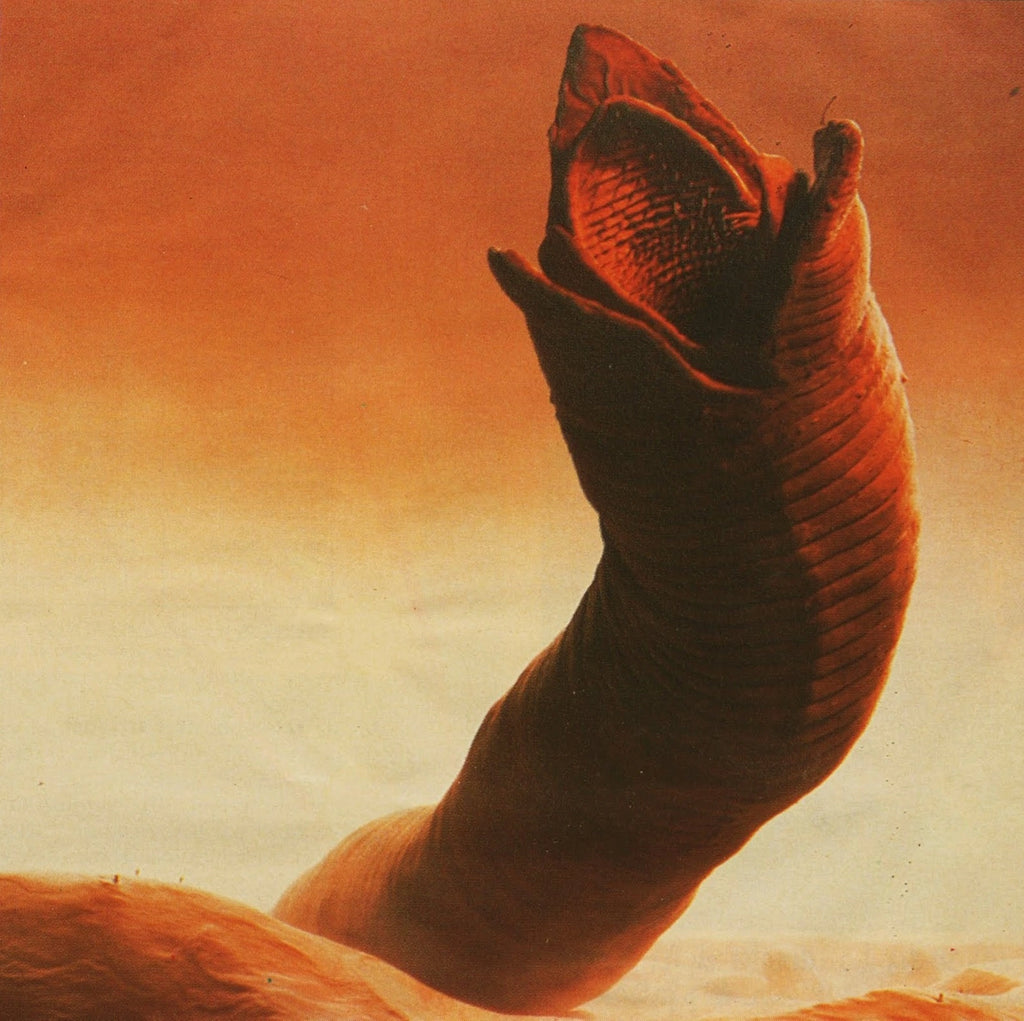Sandworm Care and Maintenance

Sandworm (Shai-Halud) Care Sheet for Bio-Active Vivarium
Difficulty: Highly Advanced
Sandworms are a diurnal fossorial species found in the deserts of Arakis, in the driest climates possible. They generally stay under the surface unless they sense a vibration to investigate.
These invertebrates range from a light tan to a dark brown and are covered in huge leathery segmented scales. Their mouths have thousands of long sharp teeth, Once they lose a tooth it is quickly regrown and unnoticed, so do not panic when this happens.
They take hundreds of years to mature and grow to an adult size of 1,200 feet or more, so it is wise to make sure you have enough resources and family to help take care of your new pet. They can live for thousands of years and there are unconfirmed reports of them growing more than 1,500 feet.
What You Need for a Bioactive Sand Worm Enclosure:
- Custom-built enclosure-minimum 4 million gallons for juveniles
- 36qt BioDude Terra Sahara Substrate (x477,426)
- Large Texas-Oklahoma-Mexico Flagstone/Slate Rock (x10,000 cases)
- Elephant Skin Stone (x100,000)
- Arid Springtail cultures (x200,000)
- Milkback or Dairy Cow Isopods (x400,000)
- Mr. Heater Propane Heater, 40,000 BTU, Model# MH40LP (x33)
- 2100lb barrels of Sand (x5)
- Barrels Calcium (x5)
- Large Quartz Boulders (x5)
- Bulk Vitamin D supplement bricks (x5)
Terrarium Size:
We recommend a minimum of 4 million gallons for juveniles, as they get larger they will need their own desert as they are highly active, traveling hundreds of miles in their home to search for food and establish their territory.
Lighting:
Sandworms are capable of surviving without UVB, as they only surface when disturbed. You can mix bulk barrels of Vitamin D supplement with your substrate.
Heating
These worms are used to a large gradient, with daytime temperatures soaring to 120° and nights falling into the low 30s. Their substrate keeps them thermoregulated, helping keep an even temperature throughout the day and night.
- Basking zone temperature: 115°F
- General air temperature: 75-80°F
- Nighttime temperature: 65-70°F
Humidity:
Sandworms require the driest conditions possible, with humidity leading to sickness and any water causing death. We recommend leaving your substrate out to dry for a few days to make sure there is absolutely no moisture.
Substrate:
A thick layer of bioactive-compatible substrate is essential to creating a successful bioactive enclosure. To make your own, You will need a rocky mainly sand mix that mimics the conditions of their home. If you want to make your own, you will need a mixture of 65% play sand, 20% mixed gravel, and 15% fine sand. Mix that with large rocks of varying mineral compositions, and an appropriate amount of Bio Shot to inoculate your soil with beneficial microfauna. This layer of soil should be as deep as possible.
Alternatively, you can let The Bio Dude do the work for you with The Bio Dude’s Terra Sahara DUNE bioactive substrate kit. To make the substrate functional, be sure to add arid clean-up crew organisms like large isopods, powder isopods, and arid springtails.
Decorating the Enclosure:
Enclosure décor is more than just making your setup look good. It’s also an important part of providing environmental enrichment to your worm, which enhances your pet’s quality of life by providing opportunities for them to express their natural behaviors.
Large boulders like the ones they would normally encounter in their territory are great, along with broken-down buses that mimic the harvesters they enjoy destroying.
Feeding Your Sandworm:
As filter feeders, their main diet is composed of inorganic materials: sand and crust from the upper tectonic plates.
It is also theorized they sift for sand plankton, and the reason they hunt for vibrations outside of being highly territorial is to supplement their diet with vitamins they cannot find in the ground. We recommend adding new sand and Terra Sahara monthly to make sure they do not run out of nutrients.
Supplements:
You can mix in bulk barrels of Vitamin D, Calcium, Granite, and Silica to help prevent nutrient deficiencies.
Tips:
Avoid making loud noises around your enclosure as this can lead to unnecessary stress. Please do not attempt or let anyone claiming to be Muad'Dib ride your Sand Worm for safety reasons. This causes them great discomfort and possible interplanetary warfare. Check to make sure you have the correct permits before obtaining your new Sandworm. Mix all components with a demolition-rated excavator to ensure thorough blending.
Care information courtesy of Frank Herbert and Dune Wiki.
- Customer Care










